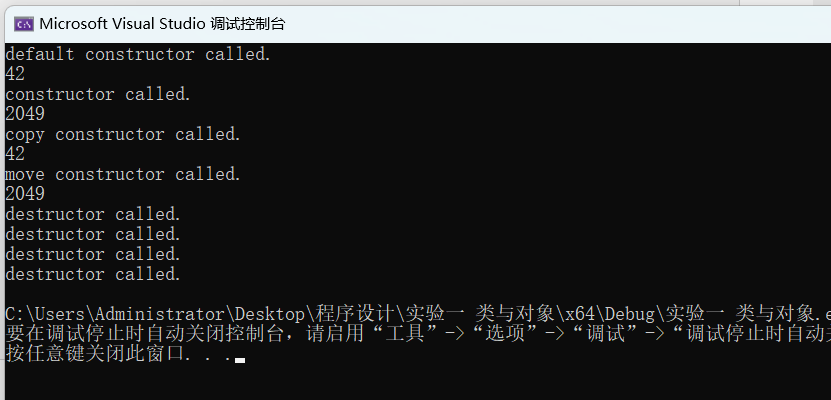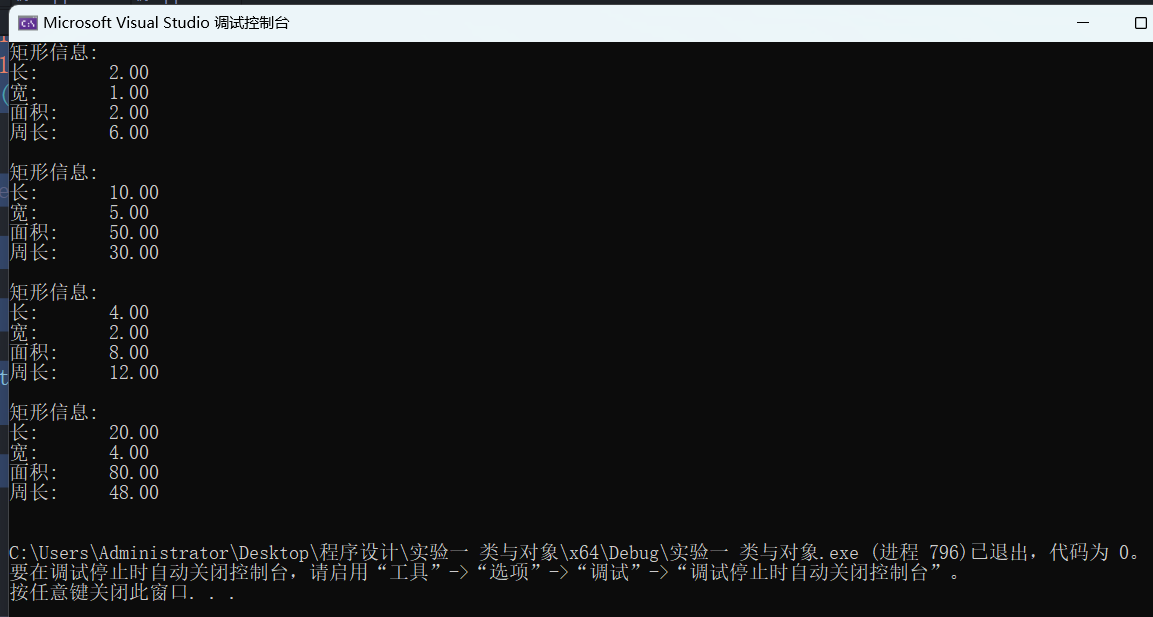实验一 类与对象
试验任务一
task 1:
#include <iostream> #include <string> #include <vector> int main() { using namespace std; string s1; // 创建一个string对象 string s2{ "c plus plus" }; // 创建一个string对象,并初始化 string s3{ s2 }; // 创建一个string对象,并用s2对其进行初始化 string s4 = s2; // 创建一个string对象,并用s2对其进行初始化 s1 = "oop"; vector<string> v1; // 创建一个vector对象 v1.push_back(s1); // 向v1末尾添加数据项s1 v1.push_back(s2 + "1"); v1.push_back(s3 + "2"); v1.push_back(s4 + "3"); // 输出方式1:使用自动类型推导、范围for cout << "output1: " << endl; for (auto item : v1) cout << item << endl; // 输出方式2:使用自动类型推导、迭代器 cout << "ouput2: "; for (auto p = v1.begin(); p != v1.end(); ++p) cout << *p << endl; // 输出方式3:使用自动类型推导、索引 cout << "output3: " << endl; for (auto i = 0; i < v1.size(); ++i) cout << v1[i] << endl; vector<string> v2{ v1.rbegin(), v1.rend() }; // 使用vector对象v1极其迭代器,构造对象v2 cout << "v2: " << endl; for (auto item : v2) cout << item << endl; }

task 2:
#include <iostream> #include <string> #include <vector> #include <cmath> #include <cstdlib> #include <time.h> // 定义模板函数,用于输出vector容器对象元素的值 template<typename T> void output(const T& obj) // 引用作为函数参数 { for (auto item : obj) std::cout << item << " "; std::cout << std::endl; } int main() { using namespace std; vector<int> v1{ 1, 9, 8, 4 }; v1.insert(v1.begin(), 2022); // 在v1.begin()之前的位置插入 v1.insert(v1.end(), 2023); // 在v1.end()之前的位置插入 cout << "v1: "; output(v1); v1.pop_back(); // 从v1尾部删除数据项 v1.erase(v1.begin()); // 删除v1.begin()位置的数据项 cout << "v1: "; output(v1); vector<string> v2{ "《1984》", "《动物农场》", "《美丽新世界》" }; cout << "v2: "; output(v2); }

试验任务二
// Point类 // 相较于教材,在构造函数的写法上,采用了业界更通用的初始化列表方式 #include <iostream> using std::cout; using std::endl; // 定义Point类 class Point { public: Point(int x0 = 0, int y0 = 0); Point(const Point& p); ~Point() = default; int get_x() const { return x; } // 内联成员函数 int get_y() const { return y; } // 内联成员函数 void show() const; private: int x, y; }; // Point类的实现 // 构造函数(带有默认形参值) Point::Point(int x0, int y0) : x{ x0 }, y{ y0 } { cout << "constructor called." << endl; } // 复制构造函数 // 参数必须是自身对象的引用类型 Point::Point(const Point& p) : x{ p.x }, y{ p.y } { cout << "copy constructor called." << endl; } void Point::show() const { cout << "(" << x << ", " << y << ")" << endl; } int main() { Point p1(3, 6); // 构造函数被调用 p1.show(); Point p2 = p1; // 复制构造函数被调用 p2.show(); Point p3{ p2 }; // 复制构造函数被调用 p3.show(); cout << p3.get_x() << endl; }

试验任务三
#include <iostream> #include <iomanip> using std::cout; using std::endl; // 定义时钟类Clock class Clock { public: Clock(int h = 0, int m = 0, int s = 0); Clock(const Clock& t); ~Clock() = default; void set_time(int h, int m = 0, int s = 0); void show_time() const; private: int hour, minute, second; }; // 类Clock实现 Clock::Clock(int h, int m, int s) : hour{ h }, minute{ m }, second{ s } { cout << "constructor called" << endl; } Clock::Clock(const Clock& t) : hour{ t.hour }, minute{ t.minute }, second{ t.second } { cout << "copy constructor called" << endl; } void Clock::set_time(int h, int m, int s) { hour = h; minute = m; second = s; } void Clock::show_time() const { using std::setw; using std::setfill; cout << setfill('0') << setw(2) << hour << ":" << setw(2) << minute << ":" << setw(2) << second << endl; } // 普通函数定义 Clock reset() { return Clock(0, 0, 0); // 构造函数被调用 } int main() { Clock c1(13, 1, 6); // 构造函数被调用 c1.show_time(); c1 = reset(); // 理论上:复制构造函数被调用 c1.show_time(); Clock c2(c1); // 复制构造函数被调用 c2.set_time(6); c2.show_time(); }

试验任务四
#include <iostream> // 定义一个简单抽象类 class X { public: X(); // 默认构造函数 ~X(); // 析构函数 X(int m); // 构造函数 X(const X& obj); // 复制构造函数 X(X&& obj) noexcept; // 移动构造函数 void show() const; // 显示数据 private: int data; }; X::X() : data{ 42 } { std::cout << "default constructor called.\n"; } X::~X() { std::cout << "destructor called.\n"; } X::X(int m) : data{ m } { std::cout << "constructor called.\n"; } X::X(const X& obj) : data{ obj.data } { std::cout << "copy constructor called.\n"; } X::X(X&& obj) noexcept : data{ obj.data } { std::cout << "move constructor called.\n"; } void X::show() const { std::cout << data << std::endl; } int main() { X x1; //默认构造函数被编译器自动调用 x1.show(); X x2{ 2049 }; x2.show(); // 构造函数被编译器自动调用 X x3{ x1 }; // 复制构造函数被编译器自动调用 x3.show(); X x4{ std::move(x2) }; // 移动构造函数被编译器调用 x4.show(); }

line33 默认构造函数
line35 构造函数
line37 复制构造函数
line39 移动构造函数
每一个构造函数结束后,都会用到析构函数
试验任务五
#include <iostream> #include <iomanip> class Rectangle { public: Rectangle(); Rectangle(double l, double w); Rectangle(const Rectangle & obj); ~Rectangle() = default; void resize(double l_times, double w_times); void resize(double times); double len() const; double wide() const; double area() const; double circumference() const; private: double length; double width; }; Rectangle::Rectangle() { length = 2; width = 1; } Rectangle::Rectangle(double len, double wide) { length = len; width = wide; } Rectangle::Rectangle(const Rectangle& obj) : length{ obj.length }, width{ obj.width } {} void Rectangle::resize(double l_times, double w_times) { length *= l_times; width *= w_times; } void Rectangle::resize(double times) { length *= times; width *= times; } double Rectangle::circumference() const { return (length + width) * 2; } double Rectangle::area() const { return length * width; } double Rectangle::len()const { return length; } double Rectangle::wide()const { return width; } // 普通函数, 用于输出矩形信息 void output(const Rectangle& rect) { using namespace std; cout << "矩形信息: \n"; cout << fixed << setprecision(2); // 控制输出格式:以浮点数形式输出、小数部分保留两位 cout << left<<setw(10)<< "长:" << setw(10) << rect.len() << endl; cout <<left<< setw(10) << "宽:" << setw(10)<< rect.wide() << endl; cout << left<<setw(10)<<"面积:" << setw(10)<<rect.area() << endl; cout << left<< setw(10) << "周长:" << setw(10)<<rect.circumference() << endl << endl; } // 主函数,测试Rectangle类 int main() { Rectangle rect1; // 默认构造函数被调用 output(rect1); Rectangle rect2(10, 5); // 带有两个参数的构造函数被调用 output(rect2); Rectangle rect3(rect1); // 复制构造函数被调用 rect3.resize(2); // 矩形rect3的长和宽同时缩放2倍 output(rect3); rect3.resize(5, 2); // 矩形rect3的长缩放5倍, 宽缩放2倍 output(rect3); }

实验总结
基本了解类与对象的大概内容
编程时要耐心细节







 浙公网安备 33010602011771号
浙公网安备 33010602011771号